On Wednesday 28th June 2017 at 4.30am, an iPhone alarm was ringing somewhere near to the three counties roundabout in Camberley, in actual fact that familiar tune was unmissably right next to my ear. I was kindly offered a lift to Reading railway station, where the 5.59am train to Paddington was waiting for me, my bag and my suit carrier. By 7.15am I had arrived at St Pancras International via a black taxi ride (must support the London Cabbie) who was in more belligerent mood than usual about the state of the world, in particular TfL and Uber. I proceeded to get lost for half an hour as my bearings on Eurostar stretched as far back as Waterloo but not beyond, nevertheless I found Edward Griffiths and Silvano Giraldin outside Searcy’s Champagne Bar in good humour and in good time.

The clue to the meeting point was two fold, the word Champagne being the biggest but also that the Champagne Study Tour leader and Chairman of the Judges of The Gold Service Scholarship, Edward Griffiths is a board member of Searcy’s: Prior to being employed by Westbury Street Holdings (WSH), Edward spent 15 years from 2001 to 2016, as Deputy Master of the Royal Household, as such he was responsible for all internal operations, including all hospitality and entertaining delivery at home and for State Visits abroad. Silvano Girlaldin was to act as lead contact to our hosts – The Rapeneau family – in Champagne. Silvano is the man who launched a thousand careers in restaurant service and by 1990 Silvano had created the original blueprint for the Royal Academy of Culinary Arts for Front of House Service, he is also a driving force behind those Awards as well as a significant voice in the Gold Service Scholarship today.
We were in good hands!
Next to arrive was Piers Zangana of Susa Comms . Piers runs the social media presence for the Gold Service Scholarship with the Instagram and Twitter accounts proving popular, informative and educational with up-to-the-minute stories of the key activities and personalities. Piers was equipped with an upscale SLR Camera plus an iPhone and also carried what I used to call a ‘meeting microphone.’ This latter apparatus, when attached to the filming technology, allowed the most effective sound input for short, sharp, social media info-bites. Piers must have taken over a thousand photos and short videos over the three days, was constantly and professionally thinking creatively while keeping all in good humour as he photo’d, videod and posted! His contribution has undoubtedly raised the awareness through social media and assisted in the right way with the quality of the Gold Service Scholarship brand.
As Events and Administration Manager, Katie Peckham-Cooper had arranged; Stephenie Beresforde – the 2017 Scholar – and her partner Lukas Andr, Alexandra-Iulia Caciuc, Sophia Warland and Ashley Best all arrived in good time at Searcy’s for the one hour journey through the organised chaos that is known as queueing, checking-in and boarding a Eurostar. The two hour journey to Paris was smooth and uneventful, as was the walking transfer across a small part of Paris from Gare du Nord to Gare de L’Est. A brief lunch at the station, memorable mainly for leaving my only pair of glasses at the table was followed by taking the TGV to Reims which took under an hour on an impressive nothing-like-it-in-Britain ‘double-decker’ train.
Immediately upon arrival in Reims, we were greeted by Corinne Couchou-Meillot, who was to be our constant companion and impeccable host for the duration of the Study Tour.
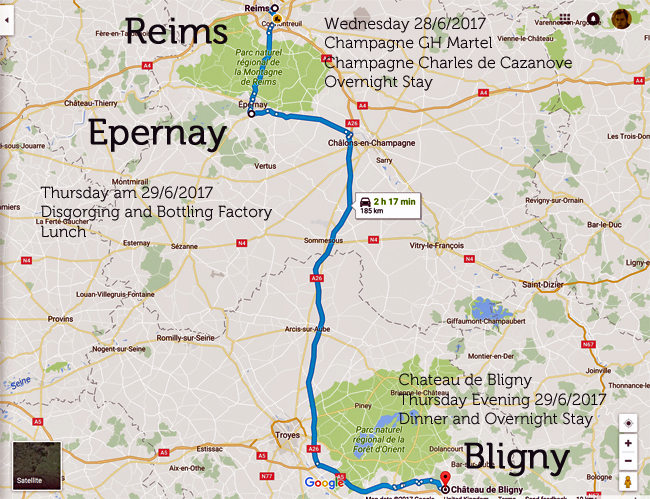
Over the next two and a half days we were to be fed, watered, educated and entertained faultlessly by the Rapeneau family and their representation. The Study Tour was geographically spread across the Region, taking in Reims, Epernay and then a two hours drive to Bligny on the southern border of Champagne.

From front to back left: Silvano Giraldin, Stephanie Beresforde, Alexandra Caciuc, Sophia Warland. From front to back right: Corinne Couchou-Meillot, Edward Griffiths, Piers Zangana, Ashley Best, Lukas Andr.
The sheer breadth and scope of the assets owned and managed by the Rapeneau family is most impressive. Below is a pictorial representation of the highlights of the familiy’s assets. On the Wednesday afternoon, from a Reims base we sampled many of the Champagnes the family have developed – from the elegant, complex, stylish Champagnes – through the richer, brioche tones – to the crisper, mineral and lighter notes of Champagne.
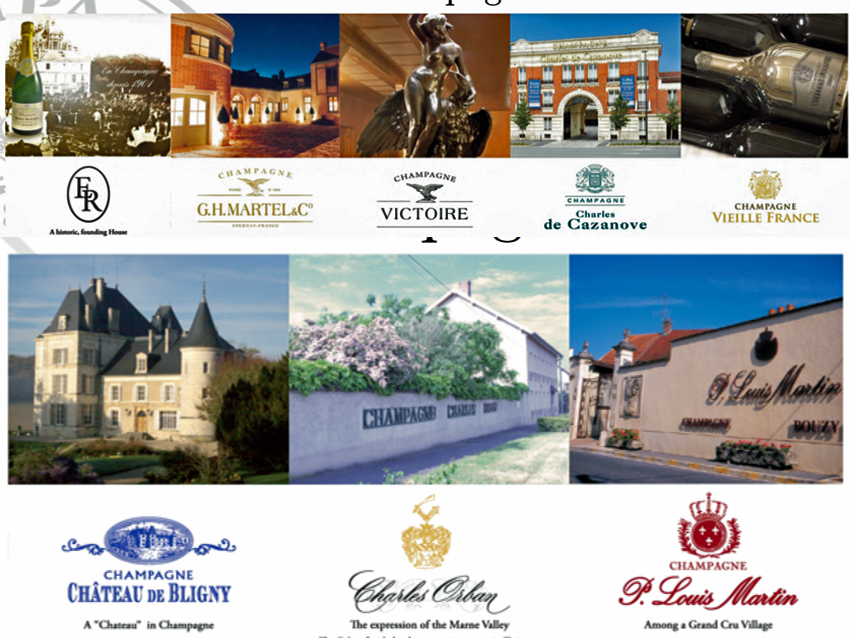
The following morning the focus was on GH Martel in Epernay which was acquired by the Rapeneau family in 1979. From 4 July 2015, The GH Martel Cellars were classified by UNESCO as a Heritage Site, along with Veuve Clicquot, Heidseick & Taittinger. (This award extends to the historical, well known and impressive “Crayeres,” or Chalk Cellars , under the Saint-Nicaise hill in Reims.)
The group were also kindly provided with the insight of a visit around a production factory. This process takes bottles from the point where they enter the production centre (after second fermentation, riddling and aging but still on their lees) to leaving the factory disgorged, liqueur d’expédition added, Champagne cork applied, labelled and packaged. A one minute summary video shows some of the process and ends with a 10 second clip of each Tour member giving their one word summary feeling of the experience. (Switch to browser mode from ‘reader’ to view on mobile device).
It is easy to see how hands-on the Rapeneau family continue to be in their Champagne business. Christophe Rapeneau joined the family business as soon as he’d graduated in oenology from the University of Reims in 1983. He spent his first few years modernising the fermenting room and production system in order to guarantee the authenticity of his work. Today, it is worth noting that around 51.8 % of the total production of Champagne is sold in France, 25,6 % of the total production of Champagne is sold in the rest of Europe, 22,6 % of the total production of Champagne is sold in the rest of the world.
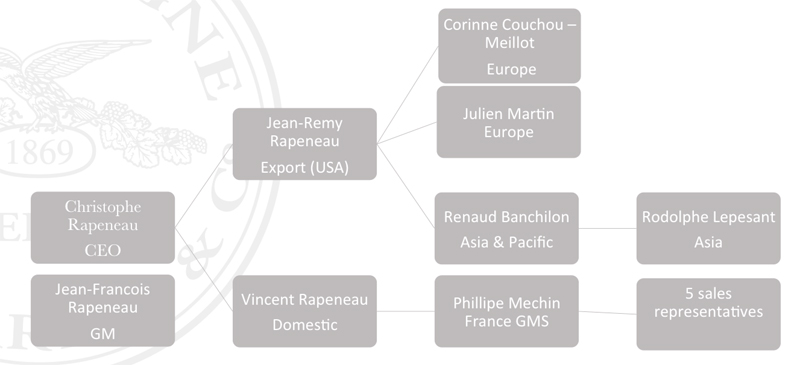
While Jean-Francois Rapeneau is the General Manager, his son Vincent Rapeneau is responsible for sales to the domestic French market and has a management structure with a set of representatives to grow the business. Christophe Rapeaneau has just been awarded by the IWC Sparkling Wine Maker of the Year 2017, Christophe is the CEO and his son Jean-Remy Rapeneau looks after Exports: USA is his personal responsibility, however he has managers looking after Europe and Asia Pacific. Our host Corinne Couchou-Meillot, has been part of the Rapeneau family business since December 1998. She has witnessed dramatic growth across all sectors of the business, and reports into Jean-Remy Rapeneau.
The original founder was Ernest Rapeneau, and today the business remains 100% in family ownership. Now with their 5th family generation in employment they have over 200 Hectares in direct ownership while sourcing and working with over 500 vine growers and families covering at least 700 Hectares. There are eight worksites (Grauves, Bouzy, Chamery, Troissy, Blesmes, Crugny , Broyes, Bligny) and they see annual production of over 8 million bottles.
On the Thursday afternoon the Group visited the resting place of Dom Pierre Perignon.
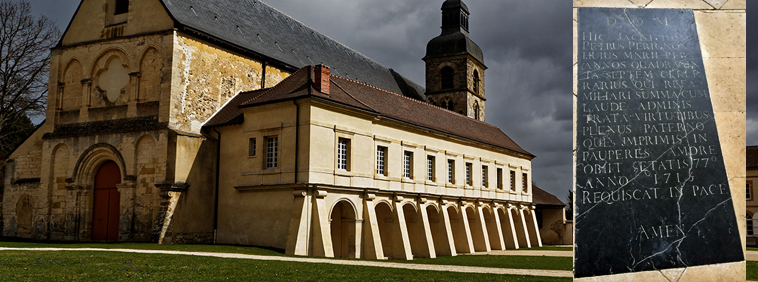
Dom Perignon was born in Sainte-Menehould, 1638. In 1668, he was transferred to the Abbey of Hautvillers, where he was credited with the invention of sparkling champagne, at a time when the wines were predominantly non-sparkling red. He passed away in 1715 in Hautvillers, his resting place is in the local Abbey. The buildings have recently been acquired and restored by Moet & Chandon who produce the prestigious cuvee Dom Perignon in his honour.
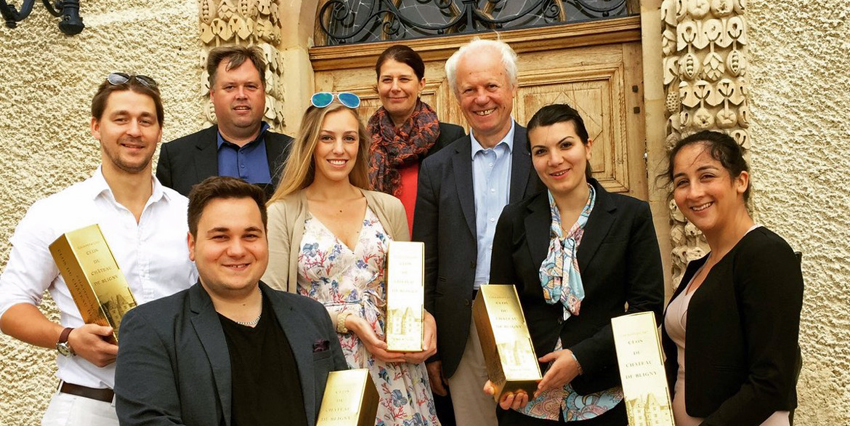
Thursday evening we arrived at Château de Bligny. An extraordinary building, lovingly restored and dating back to various centuries. Jean-Remy Rapeneau (and his father Christophe) proved a most charming and engaging host of a memorable dinner and stay in this remarkable property. The château and its land have a great historic, architectural and wine-making heritage.
Château de Bligny is a unique champagne property. It is the only Champagne to enjoy a “Château” appellation as this requires the property to be legally both a champagne harvester and producer. Further; the next morning we were shown the “Clos” that produces the ‘Clos du Chateau de Bligny.’
To understand a “Clos” better it is worth examining some background – there are the three traditional varietals in the making of Champagne: Chardonnay, Pinot Noir and Pinot Meunier; in fact there are a further older three that are recognised: Arbane, Petit Meslier, Pinot Blanc. A “Clos” has to be registered with the Institut national de l’origine et de la qualité (INAO). A parcel needs to be closed by a wall, hedge or fence. Whereas most champagnes are made from multiple crus and years, a ‘Clos’ is more a “mono cru” – In context, the entire Champagne Region boasts only 31 registered ‘Clos’ covering 0.1% or 35 Ha of production. Details of Champagne Clos du Château de Bligny – Cuvee 6 Cepages – is provided in the diagram below. The “Clos” at Château de Bligny is less than 1 Ha.
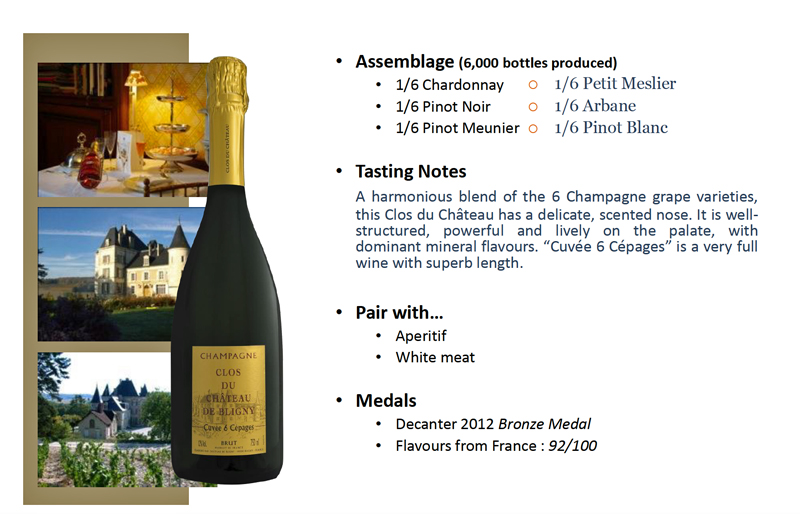
As a final general observation on the Scholarship finalists, one might imagine that a Sommelier in a top end restaurant is somewhere between a sales manager and a consultant of wine, with perhaps the emphasis on the sales? I found that each of the finalists observed, who by definition are on the younger side of the profession (22-28), exhibited a depth of appreciation and knowledge of wine that I had not expected. In the modern age, the enthusiasm of the high achievers clearly leads them to Wine and Spirit Education Trust (WSET) courses (of various levels) as well as professional tastings and educational visits. Much as a Sous Chef in a top end dining kitchen has exprience of all the Sections and can step in to assist or inform a particular Chef de Partie, then perhaps so too may the modern restaurant manager with their Sommelier?!
The journey home was comfortable and uneventful, no doubt a group of people completely satisfied with the knowledge gained or should I say knowledge imbibed!
For further information:
See: Traditional Method of Champagne Production is succinctly explained.
See: Gold Service Scholarship Part 1: An Overview
See: Gold Service Scholarship Competition Outline
See: Gold Service Scholarship Prizes 2018



